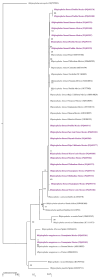Molecular Detection of Kinetoplastid Species in Ticks and Fleas Associated with Dogs and Humans in Mexico
- PMID: 39770332
- PMCID: PMC11728770
- DOI: 10.3390/pathogens13121072
Molecular Detection of Kinetoplastid Species in Ticks and Fleas Associated with Dogs and Humans in Mexico
Abstract
The Trypanosomatidae family encompasses around 24 genera of unicellular protozoans, many of which are transmitted by various hematophagous arthropods, particularly members of the Orders Diptera and Hemiptera. Fleas and ticks-an understudied group of ectoparasites-have been shown to be hosts of a wide and crescent variety of trypanosomatid species. Further, fleas and ticks of companion animals have been particularly neglected in trypanosomatid surveillance despite the proximity to human populations and the anthropophagous habits of many of these arthropods, which can potentially act as vectors of zoonotic trypanosomatids. We aimed to identify the presence, characterize the species, and establish the prevalence of Kinetoplastids, including members of the Trypanosomatidae family, in ectoparasites collected from dogs and humans from Mexico. A total of 537 ectoparasite specimens belonging to six ectoparasite taxa (Amblyomma mixtum, A. tenellum, Ctenocephalides felis felis, Pulex simulans, Rhipicephalus linnaei, and Rh. sanguineus s.s.) were collected from 15 States of Mexico. An 800 bp fragment of the 18S-rDNA gene from kinetoplastids was amplified and sequenced. The presence of two agents (Trypanosoma caninum and Parabodo sp.) was detected in R. linnaei ticks and one (Blechomonas lauriereadi) in the cat flea Ct. felis felis. This is the first record of genetic material of kinetoplastid species in ectoparasites from dogs and humans in Mexico.
Keywords: Blechomonas lauriereadi; Parabodo sp.; Rhipicephalus sanguineus s.l.; Trypanosoma caninum; ectoparasites.
Conflict of interest statement
The authors declare no conflicts of interest.
Figures





Similar articles
-
Molecular detection of Rickettsia felis in fleas and ticks collected from dogs and cats of Puebla, Mexico.Zoonoses Public Health. 2023 Mar;70(2):176-183. doi: 10.1111/zph.13011. Epub 2022 Nov 21. Zoonoses Public Health. 2023. PMID: 36409281
-
Fleas and Ticks in Carnivores From a Domestic-Wildlife Interface: Implications for Public Health and Wildlife.J Med Entomol. 2016 Nov;53(6):1433-1443. doi: 10.1093/jme/tjw124. Epub 2016 Aug 18. J Med Entomol. 2016. PMID: 27539151
-
Survey of ectoparasites affecting dog and cat populations living in sympatry in Gamo Zone, Southern Ethiopia.Vet Med Sci. 2024 May;10(3):e1413. doi: 10.1002/vms3.1413. Vet Med Sci. 2024. PMID: 38504631 Free PMC article.
-
Dog ectoparasites as sentinels for pathogenic Rickettsia and Bartonella in rural Guatemala.Acta Trop. 2024 Dec;260:107401. doi: 10.1016/j.actatropica.2024.107401. Epub 2024 Sep 12. Acta Trop. 2024. PMID: 39277155
-
Arthropod-borne diseases in homeless.Ann N Y Acad Sci. 2006 Oct;1078:223-35. doi: 10.1196/annals.1374.041. Ann N Y Acad Sci. 2006. PMID: 17114713 Review.
References
MeSH terms
Grants and funding
LinkOut - more resources
Full Text Sources
Miscellaneous

